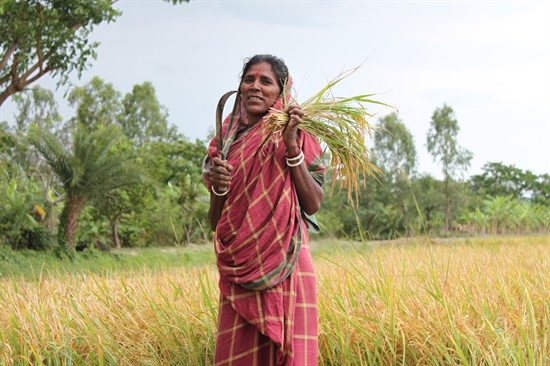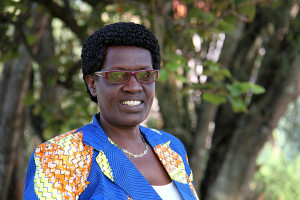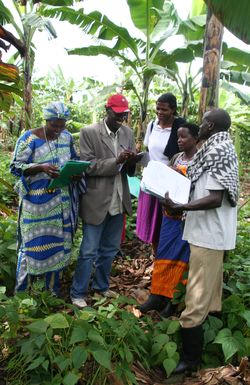The multiple benefits of sustainable agriculture in India

Photo credits: UN Women/Ashutosh Negi
Sukomol and Alpana Mondal live with their two sons on a 0.7 hectare farm in India. Due to health issues, they went into debt and were in crisis. In 2006, the Mondals decided to make a switch to an integrated farming system. With local training support, coordinated by DRCSC, a Christian Aid partner, the Mondals constructed a pond and a new drainage system consisting of a main channel through the rice field with smaller channels around the perimeter linking to the pond. The earth was used to raise the level of several of their plots. A gradual transition was made to organic paddy cultivation using Sustainable Rice Intensification methods. Native species of carp and catfish were introduced in the pond and channels, and crops such as cowpea and bitter gourd grown on trellises over the water. The water from the pond is used to irrigate a winter paddy crop as well as the vegetable plot. The effects of flooding and water-logging (major problems in this region) are lessened by the use of raised beds. More than 20 different crops are now being grown, including various spices, vegetables, oilseeds and pulses. ‘Live fences’ of mango, banana and coconut trees were also planted around the farm’s edge. The Mondals also introduced vermi-composting, began to save more seeds, and increased the number of livestock they kept. This diversified system make them more resistant to external shock. Five years on, the Mondals’ situation has been transformed. They have managed to pay off two thirds of their debt. Their income has increased due to surplus vegetables, spices, fruits, seeds and seedlings. They no longer use chemical inputs, which has lowered production costs. In the first two years, there was a decrease in rice yields but production is now back up to pre-transition levels. The family diet has improved due to steady supply of rice, fruit, fish and vegetables throughout the year.
Source: FAO (2012).
Smallholder and Family Farmers Factsheet. Burundi: Breaking down barriers for beans

Photo credits: CIAT/S. Malyon
Capitoline Ruradumu, bean research programme leader at the Institut des Sciences Agronomiques du Burundi (ISABU), has been working hard with her team and partners to restore bean research programmes supporting improved food security and nutrition for Burundi’s population of 10 million.
After 17 years of civil war, Burundi needs now more than ever to intensify and improve agriculture for a growing population, most of whom live on less than $1.25 a day. Even before recent events led to food price hikes and falling incomes, less than one third of Burundians were food secure, and more than half were chronically malnourished.
In 10 years, Capitoline and her “bean team” have made much progress. Through regional germplasm exchange and capacity building, ISABU has released 17 improved bean varieties that are high yielding, early maturing, highly marketable and more nutritious. To ensure these new varieties reach farmers, researchers are building partnerships with farmers, small seed entrepreneurs and NGOs to multiply quality seed. They have also trained farmers and extension service providers in better crop management practices, communities in nutrition and entrepreneurial women in bean processing, such as bean flour production.
Mixing it up in Uganda: Biodiversity bugs pests

Photo credits: Bioversity International/P. De Santis
Pulse crops are one of the most sustainable crops a farmer can grow, and also an economically viable crop for smallholder farmers. In Uganda, farmers have however been struggling to maintain the quality and yield of their common bean crops because of pests and diseases. Inter-cropping, or alternating different crops, has been known to help repel pests and diseases while increasing farm biodiversity. But recent trials lead by Bioversity International in Uganda suggest that even mixing varieties resistant to certain pests and diseases, with those which are more susceptible, also significantly reduces the incidence of that pest or disease. A key aspect of these trials focused on tapping into the diversity of traditional pulse varieties that exist in Uganda, varieties which are often preferred by farmers in terms of taste and traditional use. Further, planting varieties with different maturing times means that farmers can maintain consistent cash flow and stable food availability throughout the year.